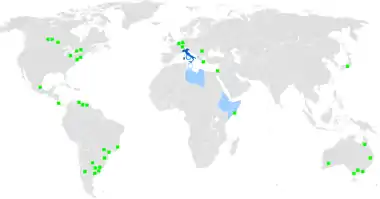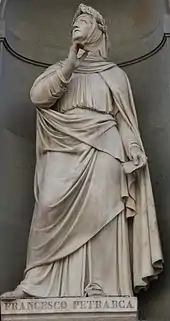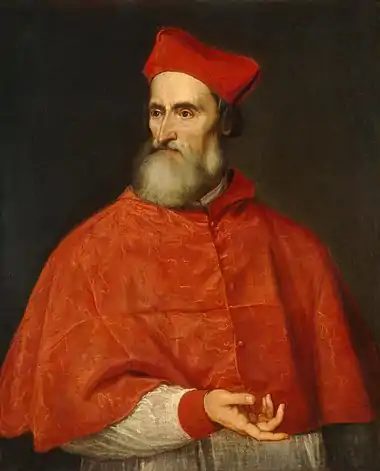Accademia della Crusca
The Accademia della Crusca (pronounced [akkaˈdɛːmja della ˈkruska]; "Academy of the Bran"), generally abbreviated as La Crusca, is a Florence-based society of scholars of Italian linguistics and philology. It is the most important research institution of the Italian language,[1] as well as the oldest linguistic academy in the world.[2]
 | |
 The geographic distribution of the Italian language in the world. | |
| Abbreviation | La Crusca |
|---|---|
| Motto | Il più bel fior ne coglie (She gathers its fairest flower) |
| Formation | 1583 |
| Headquarters | Florence, Italy |
Official language | Italian |
President | Claudio Marazzini |
| Website | accademiadellacrusca |
| This article is part of the series on the |
| Italian language |
|---|
| History |
| Literature and other |
| Grammar |
| Alphabet |
| Phonology |
The Accademia was founded in Florence in 1583, and has since been characterized by its efforts to maintain the purity of the Italian language.[3] Crusca, which means "bran" in Italian, helps convey the metaphor that its work is similar to winnowing, as also does its emblem depicting a sifter for straining out corrupt words and structures (as bran is separated from wheat). The academy motto is "Il più bel fior ne coglie" ('She gathers the fairest flower'), a famous line by the Italian poet Francesco Petrarca. In 1612, the Accademia published the first edition of its dictionary, the Vocabolario degli Accademici della Crusca,[4] which has served as the model for similar works in French, Spanish, German and English.[1]
The academy is a member of the European Federation of National Linguistic Institutes.[5]
History
Origins
.JPG.webp)
The founders were originally called the brigata dei Crusconi and constituted a circle composed of poets, men of letters, and lawyers. The members usually assembled on pleasant and convivial occasions, during which cruscate—discourses in a merry and playful style, which have neither a beginning nor an end—were recited. The Crusconi used humour, satire, and irony to distance itself from the pedantry of the Accademia Fiorentina, protected by Grand Duke Cosimo I de' Medici, and to contrast itself with the severe and classic style of that body. This battle was fought without compromising the primary intention of the group, which was typically literary, and expounded in high-quality literary disputes.
The founders of the Accademia della Crusca are traditionally identified as Giovanni Battista Deti ('Sollo'), Antonio Francesco Grazzini ('Lasca'), Bernardo Canigiani ('Gramolato'), Bernardo Zanchini ('Macerato'), Bastiano de' Rossi ('Inferigno'); they were joined in October 1582 by Lionardo Salviati[6] ('Infarinato') (1540–1589). Under his leadership, at the beginning of 1583, the Accademia took on a new form, directing itself to demonstrate and to conserve the beauty of the Florentine vulgar tongue, modelled upon the authors of the Trecento.[7]
Monosini and the first Vocabolario
One of the earliest scholars to influence the work of the Crusca was Agnolo Monosini. He contributed greatly to the 1612 edition of Vocabolario degli Accademici della Crusca, especially with regard[8] to the influence of Greek, which, he maintained, made a significant contribution to the Fiorentine idiom of the period.[9][4]
The Accademia thus abandoned the jocular character of its earlier meetings in order to take up the normative role it would assume from then on. The very title of the Accademia came to be interpreted in a new way: the academicians of the Crusca would now work to distinguish the good and pure part of the language (the farina, or whole wheat) from the bad and impure part (the crusca, or bran). From this is derived the symbolism of the Crusca: its logo shows a frullone or sifter[10][11] with the Petrarchan motto Il più bel fior ne coglie (She gathers the fairest flower).[7] The members of the Accademia were given nicknames associated with corn and flour, and seats in the form of breadbaskets with backs in the shape of bread shovel were used for their meetings.[12][13]
In 1636, Cardinal Richelieu created the Académie française on the model of the Accademia della Crusca.[14]
Beccaria and Verri opposition
The linguistic purism of the Accademia found opposition in Cesare Beccaria and the Verri brothers (Pietro and Alessandro), who through their journal Il Caffè systematically attacked the Accademia's archaisms as pedantic, denouncing the Accademia while invoking for contrast no less than the likes of Galileo and Newton and even modern intellectual cosmopolitanism itself.[15] However, since Galileo published his scientific works in his native Florentine Italian, as opposed to the Latin which was customary for academic works of the time, it has also been argued that he implicitly supported the Accademia's purpose.[16]
Baroque period
The Accademia's activities carried on with both high and low points until 1783, when Pietro Leopoldo quit and, with several other academicians, created the second Accademia Fiorentina. In 1808, however, the third Accademia Fiorentina was founded and, by a decree of 19 January 1811, signed by Napoleon, the Crusca was re-established with its own status of autonomy, statutes and previous aims.[17][3]
In the 20th century, the decree of 11 March 1923 changed its composition and its purpose. The compilation of the Vocabolario, hitherto the duty of the Crusca, was removed from it and passed to a private society of scholars; the Crusca was entrusted with the compilation of philological texts. In 1955, however, Bruno Migliorini and others began discussion of the return of the work of preparing the Vocabolario to the Crusca.[18]
In recent years
In 2007, the website E-leo compiling 3,000 drawings and writings of Leonardo da Vinci was launched, with the linguistic help of the Accademia della Crusca to decipher some of the inventor's scribblings.[19]
In August 2011, the existence of the Accademia was threatened when Giulio Tremonti and Silvio Berlusconi introduced a proposition to eradicate all public-funded entities with less than 70 members.[20] In August 2015, the Accademia's website was defaced by a hacker linked to ISIS.[21]
In February 2016, the Accademia approved the submission of an 8-year old for a new Italian word, Petaloso (full of petals).[22]
Composition


Current members
- Maria Luisa Altieri Biagi, Bologna
- Paola Barocchi, Florence
- Gian Luigi Beccaria, Turin
- Pietro Beltrami, Pisa
- Francesco Bruni, Venice
- Vittorio Coletti, Genoa
- Rosario Coluccia, Lecce
- Maurizio Dardano, Rome
- Massimo Fanfani, secretary, Florence
- Piero Fiorelli, Florence
- Lino Leonardi, Florence
- Giulio Lepschy, Reading
- Paola Manni, vice president, Florence
- Nicoletta Maraschio, Florence
- Claudio Marazzini, president, Turin
- Aldo Menichetti, Fribourg
- Carlo Alberto Mastrelli, Florence
- Sergio Mattarella, honoris causa member, Palermo
- Pier Vincenzo Mengaldo, Padua
- Silvia Morgana, Milan
- Bice Mortara Garavelli, Turin
- Giorgio Napolitano, honoris causa member, Naples
- Teresa Poggi Salani, Florence
- Ornella Pollidori Castellani, Florence
- Lorenzo Renzi, Padua
- Francesco Sabatini, Rome
- Cesare Segre, Milan
- Luca Serianni, Rome
- Angelo Stella, Pavia
- Alfredo Stussi, Pisa
- Alberto Varvaro, Naples
- Ugo Vignuzzi, Rome
- Maurizio Vitale, Milan
Italian Corresponding Members
- Luciano Agostiniani, Florence
- Federigo Bambi, Florence
- Emanuele Banfi, Milan
- Gabriella Cartago, Milan
- Claudio Ciociola, Pisa
- Lorenzo Coveri, Genova
- Emanuela Cresti, Florence
- Antonio Daniele, Padua
- Valeria Della Valle, Rome
- Giuseppe Frasso, Milan
- Claudio Giovanardi, Rome
- Riccardo Gualdo, Viterbo
- Carla Marello, Turin
- Sabatina Matarrese, Ferrara
- Alberto Nocentini, Florence
- Ivano Paccagnella, Padua
- Leonardo Maria Savoia, Florence
- Raffaele Simone, Rome
- Maria Luisa Villa, Milan
Foreign Corresponding Members
- Sandro Bianconi, Locarno
- Joseph Brincat, Malta
- Wolfgang Ulrich Dressler, Vienna
- Angela Ferrari, Basel
- Edward Fowler Tuttle, Los Angeles
- Hermann Haller, New York
- Matthias Heinz, Salzburg
- Elzbieta Jamrozik, Warsaw
- John Kinder, Perth
- Ivan Klajn, Belgrade
- Pär Larson, Florence
- Ottavio Lurati, Basel
- Martin Maiden, Oxford
- Jean-Jacques Marchand, Lausanne
- Bruno Moretti, Bern
- José Antonio Pascual Rodríguez, Salamanca
- Elton Prifti, Vienna
- Bernard Quemada, Paris
- Edgar Radtke, Heidelberg
- Brian Richardson, Leeds
- Francisco Rico Manrique, Barcelona
- Giampaolo Salvi, Budapest
- Wolfgang Schweickard, Saarbrücken
- Gunver Skytte, Copenhagen
- Harro Stammerjohann, Chemnitz
- Darío Villanueva Prieto, Santiago de Compostela
- Harald Weinrich, Munich
- John R. Woodhouse, Oxford
- Michel Zink, Paris
References
- "The Accademia". Archived from the original on 16 May 2015. Retrieved 4 August 2015.
- Informazioni sulle origini from La Crusca website.
- "The reopening of the Accademia (1811) and the fifth edition of the Vocabolario (1863–1923)". Archived from the original on 1 March 2015. Retrieved 4 August 2015.
- "The first edition of the Vocabolario (1612)". Archived from the original on 1 March 2015. Retrieved 4 August 2015.
- "Partner List". Retrieved 4 August 2015.
- "Infarinato". Retrieved 4 August 2015.
- "Origins and foundation". Retrieved 4 August 2015.
- See online manuscripts in Crusca Biblioteca Digitale
- However, Monosini's key work was the Floris Italicae lingue libri novem ("The Flower of Italian Language in a new book") published in 1604, in which he collected many vernacular Italian proverbs and Idioms, and compared and contrasted them with Greek and Latin.
- "Frullone: Traduzione in inglese di Frullone Dizionario inglese Corriere.it". Retrieved 4 August 2015.
- "The Sala delle Pale". Archived from the original on 13 May 2018. Retrieved 4 August 2015.
- "The second edition of the Vocabolario (1623)". Retrieved 4 August 2015.
- "The third edition of the Vocabolario (1691)". Retrieved 4 August 2015.
- Pío Moa (26 August 2009). "Aspectos de la Ilustración". Libertaddigital.com. Retrieved 6 June 2018.
- Alberto Arbasino. "Genius Loci" (in Italian). Archived from the original on 15 April 2012. Retrieved 30 March 2011.
- Michael Gamper (19 January 2009). "Galileo Galileis "Lettera a Cristina di Lorena" auf deutsch übersetzt und reichhaltig kontextualisiert". Literaturkritik.de (in German). Retrieved 6 June 2018.
- "The fourth edition of the Vocabolario (1729–1738) and the suppression of the Accademia (1783)". Retrieved 4 August 2015.
- "The Accademia today". Retrieved 4 August 2015.
- Nicole Martinelli (21 June 2007). "Digital Da Vinci Codes: Thousands of Leonardo's papers go online". Wired.com. Retrieved 6 June 2018.
- "Manovra, l'accademia della Crusca tra gli "enti inutili"? E' polemica: "Paradossale"". Ilfattoquotidiano.it (in Italian). 14 August 2011. Retrieved 6 June 2018.
- "Hacker dell'Isis all'attacco dell'Accademia della Crusca: "Questa guerra è appena iniziata"". Lastampa.it. 9 August 2015. Retrieved 6 June 2018.
- "Un bambino inventa una nuova parola: "petaloso". L'Accademia della Crusca gli dà ragione". Illibraio.it (in Italian). 24 February 2016. Retrieved 6 June 2018.
Further reading
- (in Italian) Yates, Frances A. "The Italian Academies", in: Collected Essays; vol. II: Renaissance and Reform; the Italian Contribution, London, Routledge & Kegan Paul, 1983 ISBN 0-7100-9530-9
- (in English) Wiesner-Hanks, Merry E. Early Modern Europe, 1450–1789. Cambridge: Cambridge University Press, 2006 ISBN 0-521-80894-4
External links
- Official website

- The search for Some Historical References of Academy (in Italian)
- Dictionary of Academy of Bran the online version of editions 1612 through 1923 (in Italian)
- Academy of Bran and Some Historical References (in Italian)
- Accademia Della Crusca Collection From the Rare Book and Special Collections Division at the Library of Congress
